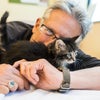
Day 7: We spot a baby hippo bobbing in the muddy water beside her mother, not any bigger than the adult behemoth's gigantic snout. These are such interesting animals. One hippo fact I remember reading in preparation for this trip, babies can suckle underwater.
Our guide for this leg of the journey is Peter: a tall and strikingly handsome man who clearly loves both his nation and its animals. While every guide has been helpful and informative, Peter is the first who appears as mesmerized by what we're looking at as we are. His field guides are well-worn, and he is consistently incredibly impressive in his ability to spot movement and then identify an animal from great distance. He tells us that hippos are the most feared of the animals here, especially feared by the tribal people who live near them. Not predatory, of course, these mud-loving herbivores are able to render a man or a crocodile in two with one snap of their immense jaws and powerful incisor teeth which serve no function for eating (eating served by large lips which rip grasses from the ground), that victim being so unfortunate as to wander across a cranky hippopotamus heading to or from his water.
Peter tells us two stories of things he personally witnessed. First, a wildebeest baby grabbed by the tail by a Nile crocodile while the baby was trying to cross a pond; a hippo surfaced, grabbed the crock by his own tail, and gently shook the animal until the baby was released. Second, a zebra trying to make it to the other side of a stream, caught by the current; again a hippo surfaced, this time creating a solid wall with his body, blocking the current and allowing the zebra to pass. Peter's view: In this place of so many predators, herbivores will at times come to help other herbivores.
Massive beyond reason, Brobdingnagian, my field guide, tells me that these amphibious giants are second only in weight to the elephant; cranky, ornery, extremely dangerous, shockingly fast, and now I'm told empathetic to other non predatory animals (or at least so at times). I can't help but think of the hippos in Fantasia, dancing on toe, clad in pink tutus. The twisted genius of Disney: turning a giant version of a generally despised rodent into a family's best friend, and making ballerinas out of these frightening and apparently unpredictable giants.
On our way home we pass a nursery herd of giraffes: five babies, some quite young and others a year or more old, being carefully watched over by one mother while the other adults go off to feed. The babies stare at us as we pass, goggle-eyed heads at the end of fire-truck ladder-long necks, knobs with tassels of hair at top, legs which seem somehow independent of the bodies, all brown blotches on a yellow background. It's a pattern which should make them stand out (as if their impossible height wasn't enough), yet works well as camouflage as the sunlight breaks through the leaves and branches. Is this really the same planet Earth as the one back home...?
